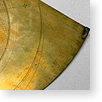
The quest for longitude was the most crucial problem in the art of navigation, often determining the success of voyages and the survival of seamen. In 1530 the cosmographer Reiner Gemma Frisius (1508-1555) proposed a method based on the difference between the time at the port of departure, retained aboard ships by mechanical clocks, and the local time measured with astronomical instruments. Each hour of difference equalled fifteen degrees of longitude, and each degree of longitude was equivalent to a continuously varying distance from the Pole to the Equator.
Astrolabe
Inv. 1103
Gualterus Arsenius, Louvain, 1572
Astrolabe
Inv. 1097
Johann Richter (Praetorius), Altdorf, 1591
Astrolabe
Inv. 1098
Gerard Mercator [attr.], Duisburg, ca. 1570
Astrolabe
Inv. 1094
Gualterus Arsenius [attr.], Flemish, ca. 1570
Astrolabe
Inv. 1100
Maker unknown, English?, late 16th cent.
Astrolabe
Inv. 1093
Thomas Gemini, English, 1550-1559
Bust of Amerigo Vespucci
Inv. 3903
Giovan Battista Foggini, 17th cent.
Hourglass
Inv. 138
Maker unknown, 17th cent.
Model of the application of the pendulum to the clock
Inv. 3450
Eustachio Porcellotti, 1860
Nautical hemisphere
Inv. 1099, 1122
Charles Whitwell, English, late 16th cent.
Single-handed dividers
Inv. 1479
Maker unknown, 17th cent.
Single-handed dividers
Inv. 1478
Maker unknown, 17th cent.
Spring-driven clock movement and dial
Inv. 3557
Johann Philipp Treffler, Florence, ca. 1659
Table-clock movement
Inv. 3821
Maker unknown, Italy, 16th cent.






















